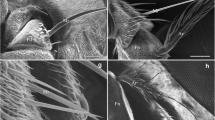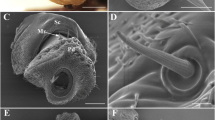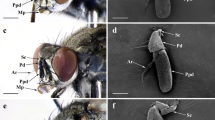Abstract
Lucilia sericata (Meigen) is a cosmopolitan synanthropic fly of forensic and medical importance, which can work as a mechanic vector of pathogens or cause myiasis of both human and sheep. As essential olfactory organs, antennae of adult L. sericata were examined with stereoscopic microscope, scanning electron microscope, and laser scanning confocal microscope. On antennal scape and pedicel, both microtirchiae and several bristles are detected, while another two structures, setiferous plaques and pedicellar buttons, are also found on the antennal pedicel. Seven subtypes of antennal sensilla are observed on antennal funiculus including one subtype of trichoid sensilla, two subtypes of basiconic sensilla, two subtypes of coeloconic sensilla, and two subtypes of sensory pits. Size and density of the former four types of sensilla on antennal funiculus are measured. Three distinctive sensillar characters of L. sericata are detected, which may contribute to greater olfactory sensitivity of this species and their wide distribution throughout the world. Unlike the common poreless pedicellar button with mechanoreceptor function, every pedicellar button in L. sericata is perforated by three pores, which might indicate potential chemoreceptor function of this structure. Besides, another unique feature is greater number of setiferous plaques in genus Lucilia than calliphorids of other genera. Expect for the common sensory pits with basiconic or basiconic-like sensilla in them, sensory pits filled with rarely described coeloconic-like sensilla are founded in L. sericata as well. After comparison with previous equivalent findings, the functions of these specific structures are discussed according to the life history of this calliphorid.





Similar content being viewed by others
References
Altner H, Schaller-Selzer L, Stetter H, Wohlrab I (1983) Poreless sensilla with inflexible sockets; a comparative study of a fundamental type of insect sensilla probably comprising thermo- and hygroreceptors. Cell Tissue Res 234:279–307
Amer A, Mehlhorn H (2006) The sensilla of Aedes and Anopheles mosquitoes and their importance in repellency. Parasitol Res 99:491–499
Bruyne M, Foster K, Carlson JR (2001) Odor coding in the Drosophila antenna. Neuron 30:537–552
Chapman RF (1998) The insects structure and function, 4th edn. Cambridge University Press, New York
Dethier VG (1971) The physiology of insect senses. Chapman and Hall, London
Dietz A, Humphreys WJ (1971) Scanning electron microscopic studies of antennal receptors of the worker honey bee, including sensilla campaniformia. J Ann Entomol Soc Am 64:919–925
Fernandes FF, Pimenta PFP, Linardi PM (2004) Antennal sensilla of the new world screwworm fly, Cochliomyia hominivorax (Diptera: Calliphoridae). J Med Entomol 41:545–551
Grassberger M, Reiter C (2001) Effect of temperature on Lucilia sericata (Diptera: Calliphoridae) development with special reference to the isomegalen- and isomorphen-diagram. Forensic Sc Int 120:32–36
Greenberg B (1970) Species distribution of new structures on fly antennae. Nat Geosci 228:1338–1339
Greenberg B, Ash N (1972) Setiferous plaques on antennal pedicels of muscoid Diptera: appearance in various species and tests of function. Ann Entomol Soc Am 65:1340–1346
Guha L, Seenivasagan T, Bandyopadhyay P, Thanvir Iqbal S, Sathe M, Sharma P, Parashar BD, Kaushik MP (2012) Oviposition and flight orientation response of Aedes aegypti to certain aromatic aryl hydrazono esters. Parasitol Res 111:975–982
Hallem EA, Dahanukar A, Carlson JR (2006) Insect odor and taste receptors. Annu Rev Entomol 51:113–135
Hunter FF, Adserballe CF (1996) Cuticular structures on the antennae of Hypoderma bovis De Geer (Diptera: Oestridae) females. Int J Insect Morphol Embryol 25:173–181
MacLeod J (1943) A survey of British sheep blowflies. Bull Entomol Res 34:65–88
McAlpine DK (2011) Observation on antennal morphology in Diptera with particular reference to the articular surfaces between segments 2 and 3 in the Cyclorrhapha. Rec Aust Mus 63:113–166
McIver SB (1969) Antennal sense organs of female Culex tarsalis (Diptera: Culicidae). Ann Entomol Soc Am 62:1455–1461
McIver SB (1975) Structure of cuticular mechanoreceptors of arthropods. Annu Rev Entomol 20:381–397
McIver SB (1985) Mechanoreception. In: Kerkut GA, Gilbert LI (eds) Comparative insect physiology, biochemistry and pharmacology. Pergamon, Oxford, pp 71–132
Mitchell BK, Itagaki H, Rivet MP (1999) Peripheral and central structure involved in insect gustation. Microsc Res Tech 47:401–415
Ochieng SA, Park KC, Zhu JW, Baker TC (2000) Functional morphology of antennal chemoreceptors of the parasitoid Microplitis croceipes (Hymenoptera: Braconidae). Arthropod Struct Dev 29:231–240
Olson DM, Andow DA (1993) Antennal sensilla of female Trichogramma nubilale (Ertle and Davis) (Hymenoptera: Trichogrammatidae) and comparisons with other parasitic Hymenoptera. Int J Insect Morphol Embryol 22:507–520
Renthal R, Velasquez D, Olmos D, Hampton J, Wergin WP (2003) Structure and distribution of antennal sensilla of the red imported fire ant. Micron 34:405–413
Rospars JP (1988) Structure and development of the insect antennodeutocerebral system. Int J Insect Morphol Embryol 17:243–294
Ross KTA (1992) Comparative study of the antennal sensilla of five species of root maggots: Delia radicum L., D. floralis F., D. antique Mg., D. platura Mg. (Diptera: Antomyiidae), and Psila rosae F. (Diptera: Psilidae). Int J Insect Morphol Embryol 21:175–197
Schneider D (1964) Insect antennae. Ann Rev Entomol 9:103–122
Setzu MD, Poddighe S, Angioy AM (2011) Sensilla on the antennal funiculus of the blow fly, Protophormia terraenovae (Diptera: Calliphoridae). Micron 42:471–477
Shanbhag SR, Muller B, Steinbrecht RA (1999) Atlas of olfactory organs of Drosophila melanogaster 1. Types, external organization, innervation and distribution of olfactory sensilla. Int J Insect Morphol Embryol 28:377–397
Shanbhag SR, Muller B, Steinbrecht RA (2000) Atlas of olfactory organs of Drosophila melanogaster 2. Internal organization and cellular architecture of olfactory sensilla. Arthropod Struct Dev 29:211–229
Smith KE, Wall R (1998) Suppression of the blowfly Lucilia sericata using odour-baited triflumuron-impregnated targets. Med Vet Entomol 12(4):430–437
Sukontason K, Sukontason KL, Piangjai S, Boonchu N, Chaiwong T, Ngern-klun R, Sripakdee D, Vogtsberger RC, Olson JK (2004) Antennal sensilla of some forensically important flies in families Calliphoridae, Sarcophagidae and Muscidae. Micron 35:671–679
Sukontason K, Methanitikorn R, Chaiwong T, Kurahashi H, Vogtsberger RC, Sukontason KL (2007) Sensilla of the antenna and palp of Hydrotaea chalcogaster (Diptera: Muscidae). Micron 38:218–223
Tenquist JD, Wright DF (1976) The distribution, prevalence and economic importance of blowfly strike in sheep. NZ J exp Agric 4:291–295
Wang X, Zhong M, Wen J, Cai J, Jiang H, Li Y, Al SM, Xiong F (2012) Molecular characterization and expression pattern of an odorant receptor from the myiasis-causing blowfly, Lucilia sericata (Diptera: Calliphoridae). Parasitol Res 110:843–851
Wall R, French NP, Morgan K (1992) Blowfly species composition in sheep myiasis in Britain. Med Vet Entomol 6:177–178
Xue WQ, Chao JM (1996) Flies of China. Liaoning Science and Technology Press, Shenyang
Zacharuk RY (1985) Antennae and sensilla. In: Kerkut GA, Gilbert LI (eds) Comparative insect physiology, biochemistry and pharmacology. Pergamon, Oxford, pp 1–69
Zhang D, Wang QK, Hu DF, Li K (2012) Sensilla on the antennal funiculus of the stomach bot fly, Gasterophilus nigricornis (Diptera: Oestridae). Med Vet Entomol 26:314–322
Zhang D, Wang QK, Liu XH, Li K (2013a) Sensilla on antenna and maxillary palp of predaceous fly, Lispe neimongola Tian et Ma (Diptera: Muscidae). Micron 49:33–39
Zhang D, Wang QK, Yang YZ, Chen YO, Li K (2013b) Sensory organs of the antenna of two medically and hygienically important Fannia species (Diptera: Fanniidae). Parasitol Res 112:2177–2185
Acknowledgements
We are grateful to Ms. Jun-Na Shi (Beijing Forestry University), who gave us invaluable help with this study. This study was supported by the Program for New Century Excellent Talents in University (No. NCET-12-0783).
Conflict of interest
The authors declare no conflict of interest.
Author information
Authors and Affiliations
Corresponding author
Additional information
D.Z. and X.-H.L. contributed equally to this work.
Rights and permissions
About this article
Cite this article
Zhang, D., Liu, X.H., Li, X.Y. et al. Antennal sensilla of the green bottle fly, Lucilia sericata (Meigen) (Diptera: Calliphoridae). Parasitol Res 112, 3843–3850 (2013). https://doi.org/10.1007/s00436-013-3573-2
Received:
Accepted:
Published:
Issue Date:
DOI: https://doi.org/10.1007/s00436-013-3573-2




